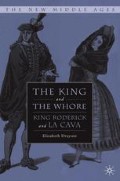Abstract
The first cultural reference to King Roderick does not appear in Spain, but in the Middle East, within the ruined medieval palace of Qusayr ‘Amra (meaning the ‘little palace of ‘Amra’), which lies in the remote Jordanian desert, amid a limitless expanse of sand traversed only by Bedouins. Built in the early eighth century with hard reddish limestone quarried from the surrounding hills, the palace dome and rounded arches have resisted the passage of time to blend unassumingly with the tones of the landscape. Yet inside a marvel is hidden, for virtually every wall is covered with fresco paintings vibrant with color and movement, which constitute one of the most important and unique art treasures of the medieval Islamic era. On the west wall, an image survives of six world rulers, one of whom is Roderick, last Visigothic king of Spain, whose startling presence in this painting predates the earliest known written accounts of the Muslim conquest of his country. The significance of this depiction of King Roderick is particularly important in terms of its implications for the earliest written Christian and Arab records of the Visigothic king’s demise, which are the sources of the legend of the king and the whore.
“History is our way of giving what we are and what we believe in the present a significance that will endure into the future, by relating it to what has happened in the past.”
Fred Donner
Access this chapter
Tax calculation will be finalised at checkout
Purchases are for personal use only
Preview
Unable to display preview. Download preview PDF.
Notes
See Richard Ettinghausen, Oleg Grabar, and Marilyn Jenkins, Islamic Art and Architecture 650–1250 ( New Haven and London: Yale University Press, 2001 ), p. 48.
David Talbot Rice, Islamic Art, 2nd edn. ( London: Thames and Hudson, 1975 ), p. 9–11.
K.A.C. Creswell, Early Muslim Architecture: Ummayads A.D. 622–750, 2 vols. ( Oxford: Clarendon Press, 1969 ), p. 406.
See Oleg Grabar, “The Paintings of the Six Kings at Qurayr Amrah,” Ars Orientalis 1 (1954), p. 186 [185–87].
Garth Fowden, Empire to Commonwealth: Consequences of Monotheism in Late Antiquity ( Princeton: Princeton University Press, 1993 ), p. 143.
Garth Fowden, Qusayr Amra: Art and Ummayad Élite in Late Antique Syria ( Berkeley and London: University of California Press, 2004 ), pp. 197–201.
Copyright information
© 2007 Elizabeth Drayson
About this chapter
Cite this chapter
Drayson, E. (2007). The Birth of a Legend. In: The King and the Whore. The New Middle Ages. Palgrave Macmillan, New York. https://doi.org/10.1057/9780230608818_2
Download citation
DOI: https://doi.org/10.1057/9780230608818_2
Publisher Name: Palgrave Macmillan, New York
Print ISBN: 978-1-349-53495-1
Online ISBN: 978-0-230-60881-8
eBook Packages: Palgrave Literature & Performing Arts CollectionLiterature, Cultural and Media Studies (R0)

